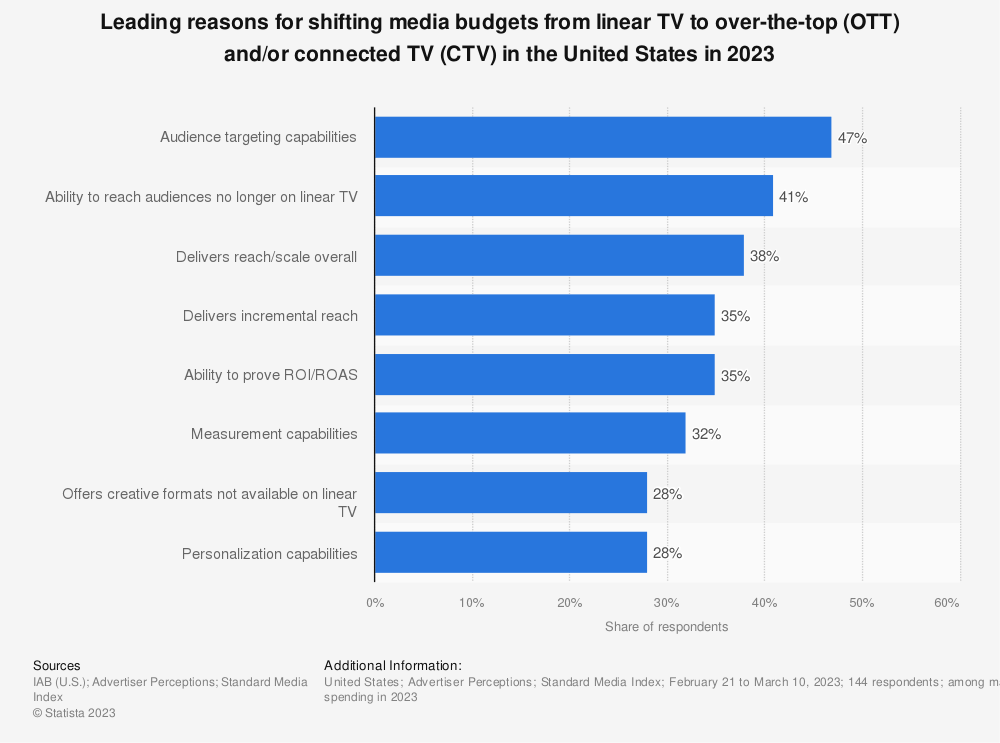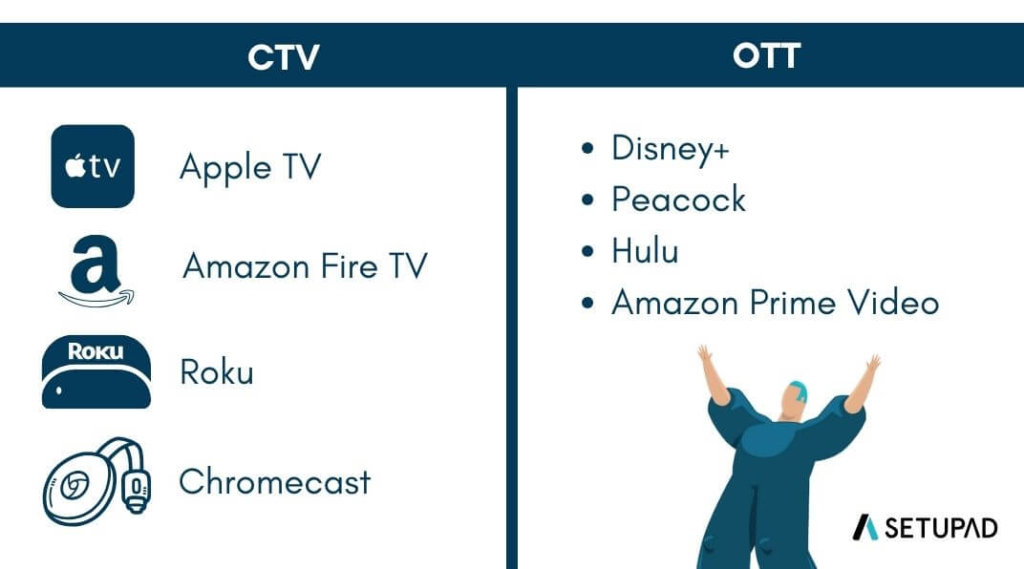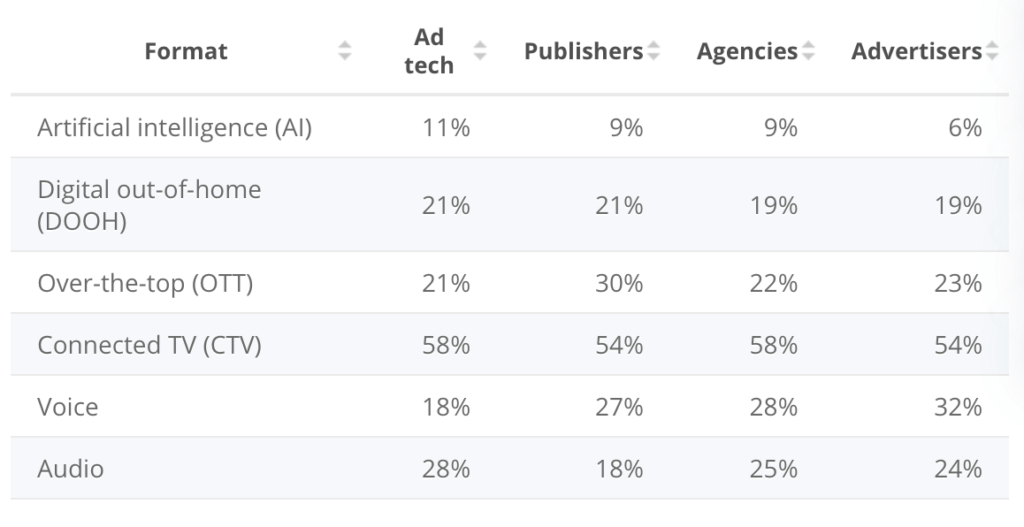OTT vs CTV in Programmatic: The Differences Explained
CTV (connected TV) and OTT (over-the-top) both offer unique opportunities to reach modern audiences. Understanding their distinctions and capabilities becomes paramount for publishers aiming to maximize their advertising potential.
This article explains the difference between OTT and CTV advertising, their role in the current advertising landscape, and the power of combining both methods for an effective multi-channel marketing strategy.
Let’s dive in!
What is Programmatic Advertising?
Programmatic advertising is the automated buying and selling of digital ad space. Before, all the processes of ordering, setting up, and reporting ads had to be done manually.
Automation reduced the amount of time publishers and advertisers were required to negotiate digital ad deals. But programmatic advertising now depends on adding data like ad performance, target audiences, and cross-domain behavioral data.
In other words, programmatic advertising uses AI and machine learning to facilitate the real-time buying and selling of ads instead of engaging in human negotiations and paying predefined prices.
The Rise of OTT and CTV
The digital media landscape has undergone significant transformation with the rise of OTT (over-the-top) and CTV (connected TV). As traditional cable subscriptions decline, consumers are navigating towards internet-based content delivery platforms, marking a notable shift towards OTT and CTV solutions.
This transition aligns with the growing importance of digital advertising, which offers precise targeting, real-time metrics, and dynamic ad placements, attributes often lacking in traditional advertising mediums.
2023 data shows that in the U.S. the main reasons for shifting ad budgets to OTT and CTV lies around the potential of these platforms to deliver targeted, wide-reaching, and effective ad campaigns to audiences who are increasingly moving away from traditional TV consumption patterns.

Source: Statista
OTT and CTV platforms can utilize user data to target ads based on demographics, viewing habits, interests, and more. This precision in targeting ensures that ads are more relevant to the viewer, potentially leading to better engagement and conversion rates.
Additionally, as viewing habits evolve, a significant portion of the audience is moving away from traditional TV (linear TV) and is instead consuming content through internet-based platforms. This shift is particularly noticeable among younger demographics.
Why Are Businesses Moving Toward OTT and CTV?
Businesses, recognizing these advantages, are increasingly moving towards OTT and CTV advertising. They see it as a strategic opportunity to engage audiences in more personalized and immersive ways, capitalize on the broader reach of OTT across multiple devices, and harness the premium, focused experience of CTV.
The shift underscores a broader trend where digital adaptability is pivotal for businesses aiming to stay relevant and competitive.
OTT and CTV: The Differences
OTT refers to the method of delivering content (including ads) over the internet, bypassing traditional distribution methods such as cable or satellite.
While you can see OTT content on a connected TV, it’s not limited to just that. You can also access OTT content on various devices, including mobile, tablets, and desktop.
CTV refers to TVs that are connected to the internet. These TVs can support OTT content, including OTT ads. A connected TV is just one of the devices where you might see OTT content or ads. But not all OTT content is viewed on CTVs.

Understanding OTT in Depth
Over-the-top (OTT) encompasses all linear TV or video on demand (e.g. AVOD) streaming content providers (e.g., Netflix, Hulu.) These content providers distribute directly to viewers through the internet.
OTT includes all devices and environments including mobile, desktop, app, web and is not exclusive to CTVs.
OTT stands for “over-the-top,” meaning over the top of the “box” and refers to video content that is accessed through the internet instead of traditional cable (“set-top-box”) or satellite TV.
Note: OTT isn’t the device on which you’re watching content, which means you could be watching OTT content on a connected TV, but also on your laptop or tablet. Some OTT examples are Netflix, Hulu, Disney+, Apple TV+ and Peacock.
Understanding CTV in Depth
Connected TV (CTV) is a subset of OTT. CTV is a TV that is connected to the internet through an internal device (e.g., Smart TV) or an external device (e.g., Apple TV). Video content is delivered to a TV screen through the internet.
CTV offers robust optimization and measurement capabilities. Using CTV for awareness campaigns is very effective.
One of the ways to track the performance of a CTV campaign is through metrics like video completion rate (VCR) and cost per completed view (CPCV). There’s also a rise of QR codes as part of an overall CTV strategy.
For example, when you include a QR code into an ad shown on CTV, your audience can pull out their mobiles and scan the code to your landing page. You can use a QR code generator to create easily scannable and trackable codes, helping to maximize user engagement.
CTV also adds enhanced targeting options, inventory selection, and real-time reporting.
Side-by-Side Comparison: OTT vs CTV
| Functionality | OTT | CTV |
| Platform | Netflix, Hulu, Youtube TV, FOX | Apple TV, Roku, Chromecast, Playstation, Xbox |
| Purpose | Deliver content and ads over the internet, bypassing traditional TV systems. | Advertise on internet-connected television devices specifically. |
| How it works? | Uses streaming services to provide content and ads to any internet-connected device. | Delivers ads to specific apps and platforms on connected TVs. |
| Focus | Think multi-device and multi-platform. | Households withconnected TVs and the specific viewing habits of this audience. |
In a ”Attitudes to Programmatic Advertising 2022” study, Nick Welch (Head of EMEA Programmatic Sales at IAS and Programmatic Trading Committee Chair at IAB Europe) mentioned: “We’re witnessing tremendous appetite across growing environments such as CTV.”
Additionally, James Collins (SVP, Media Network, Rakuten Advertising) said: “It’s positive to see that CTV remains the largest growth area for programmatic, with key learnings in this report hopefully the industry can take a step closer to capitalising on this opportunity.”
How OTT and CTV complement each other?
Here are 8 main areas in which OTT and CTV can complement each other:
- Reach and precision targeting.
OTT provides the means to deliver content and ads across various devices.
CTV, being a subset of OTT, specifically targets households using internet-connected TVs.
By using both, advertisers can capture a wider audience across multiple devices while also ensuring precision targeting for TV-centric viewers.
- Unified messaging across screens.
Marketers can maintain a consistent brand message across various devices. While the OTT strategy ensures presence on mobile and desktop platforms, CTV guarantees visibility on the big screen in households.
- Diverse ad formats.
OTT allows for diverse ad formats suitable for different devices, from shorter mobile-focused ads to longer, immersive ads on CTVs.
CTV can deliver a high-quality, TV-like ad experience, taking advantage of larger screen sizes.
- Data integration and enhanced analytics.
OTT’s wide device range offers rich data on user behaviors, preferences, and device interactions.
CTV provides detailed metrics on TV viewership patterns.
By integrating data from both sources, advertisers get a holistic view of their audience, enabling better optimization of future campaigns.
- Higher engagement potential.
Users who engage with content on mobile or desktop (OTT) might be more receptive to seeing related ads later on their CTV, or vice versa. The multi-device exposure amplifies the chances of engagement.
- Cost-effective strategy.
Using both OTT and CTV allows advertisers to allocate budgets more effectively.
While CTV might offer premium ad slots with potentially higher CPMs (cost per thousand impressions), OTT can provide broader coverage, often at a more affordable rate.
- Dynamic ad insertion.
Advanced OTT platforms offer dynamic ad insertion, allowing for real-time ad swaps based on viewer data. When combined with CTV’s capability to target specific households, this can lead to highly personalized ad experiences for viewers.
- Flexibility and redundancy.
If there are limitations or issues with one advertising avenue, having both OTT and CTV in the mix ensures that the campaign isn’t entirely affected. This dual approach offers a safety net.
How to Choose Between OTT and CTV?
In a 2022 European survey, CTV emerged as the top growth area, with 58% of ad tech stakeholders and over half of advertisers, agencies, and publishers recognizing its potential.
Conversely, OTT garnered less interest, cited by 21% of ad tech and 30% publishers, 22% of agencies and 23% of advertisers.

Source: Statista
Choosing between OTT and CTV advertising depends on your business goals, target audience, budget, and the kind of experience you want to deliver to your viewers.
1. Define your target audience
- OTT–If your target audience spans multiple devices – mobile phones, tablets, computers, and smart TVs – then OTT might be a better fit. OTT allows for a broader reach across various digital platforms.
- CTV–If you specifically want to reach households that primarily consume content on their internet-connected TVs, then CTV is the way to go.
2. Consider your budget
- OTT–Might require a broader strategy and potentially more budget because you’re targeting multiple platforms. But it can also offer a wider reach.
- CTV–Could be more focused and potentially less expensive if you’re only targeting connected TV viewers. However, the CPM (cost per thousand impressions) might be higher due to the premium nature of the audience.
3. Think about the user experience
- OTT–Offers flexibility in ad formats and lengths since the content is consumed on various devices. However, the ad experience might differ from one device to another.
- CTV–Delivers a more consistent, high-quality ad viewing experience because the content is watched on larger TV screens.
4. Consider ad inventory and fragmentation
- OTT–There might be more fragmentation due to the amount of devices, platforms, and apps. This requires a more versatile ad strategy.
- CTV–Less fragmented as it’s more specific to internet-connected TVs, but you might need to consider different strategies for various TV platforms or apps.
5. Evaluate data and targeting capabilities
- OTT–With the right platform, OTT can offer dynamic ad insertion and better targeting based on user behavior across various devices.
- CTV–CTV advertising can provide household-level targeting, which is useful if you want to engage a specific demographic or geographic segment.
6. Review measurement and reporting
- OTT–Offers a multi-platform view, which can provide insights into how your audience interacts with content across different devices.
- CTV–Focused metrics on TV viewership, which can give detailed insights into how viewers engage with content on their TVs.
7. Understand the ad environment
- OTT–Ads can appear on subscription-based platforms (e.g., Hulu) or free platforms (e.g., Tubi).
- CTV–Ads are primarily shown on apps or platforms available on internet-connected TVs.
The Future of OTT and CTV in Programmatic Advertising
There is a future for CTV and OTT advertising. Most households in the U.S. own at least one connected TV. This indicates a broad market penetration and suggests that a large portion of the population can be reached through CTV advertising.
The majority of people who own CTV devices use them to access OTT platforms. This signifies that not only are people buying CTVs, but they are also using them to consume OTT content.
Both CTV and OTT advertising have a promising future because of the growing adoption and usage by consumers. Businesses and marketers should consider these channels to effectively reach and engage with their target audience.
Conclusion
CTV and OTT are the two staples of digital advertising, each with its strengths and channels of distribution. Understanding the differences can significantly benefit publishers by improving their advertising strategies and guaranteeing a more focused and broader reach.
CTV targets households through internet-connected TVs for an immersive ad experience, and OTT reaches audiences across a variety of devices, from smartphones to tablets.
When combined, they provide marketers with a holistic strategy, ensuring comprehensive coverage across screens. This duo maximizes reach, enhances audience engagement, and allows tailored messaging.
Wrapping it up, as technology continues to progress and viewing habits shift, aligning with the capabilities of CTV and OTT not only future-proofs advertising efforts but also ensures sustained audience engagement in this dynamic digital age.
Frequently Asked Questions
What are the major differences between OTT and CTV in programmatic advertising?
OTT delivers content through the internet across various devices, while CTV specifically targets internet-connected TVs.
Which is better for my business: OTT or CTV?
It depends on your goals. OTT is broader, reaching multiple devices, whereas CTV offers a TV-like experience.
How do OTT and CTV complement each other in programmatic advertising?
Together, OTT and CTV can maximize reach and engagement. OTT covers various devices, while CTV focuses on households.
Can I use both OTT and CTV for my advertising strategy?
Yes, and it’s beneficial for a multi-channel strategy. Using both can capture a wider audience across multiple platforms and bring better results.
What factors should I consider when choosing between OTT and CTV?
You should mainly consider your target audience, budget, and desired ad experience.
What are some successful case studies of businesses using OTT and CTV effectively?
Brands often use both to target different demographics. Additionally, think about brand (e.g., Nike) ads you see on your phone, and later you see a similar ad on your CTV device. It amplifies brand recall and recognition.


